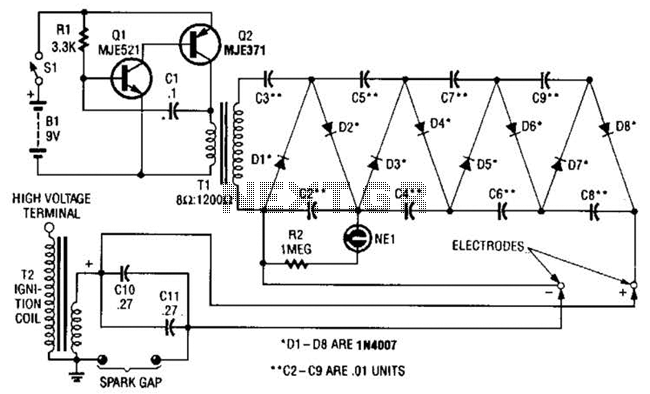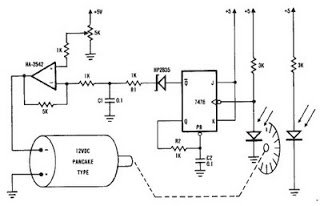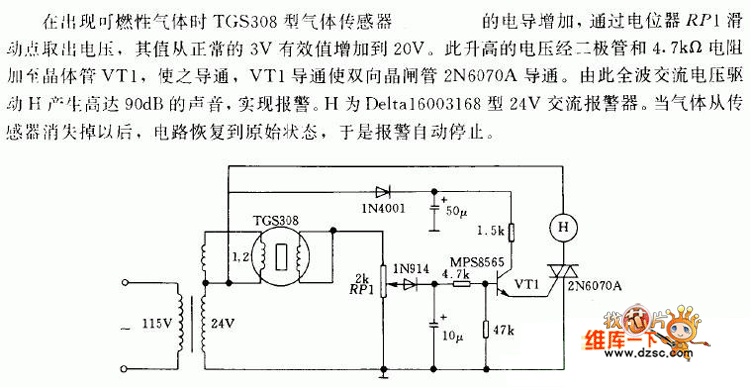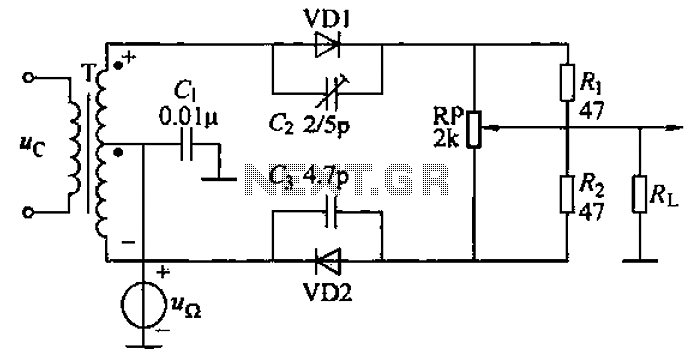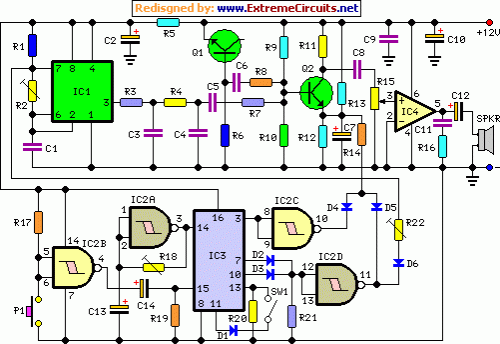
telephone number display circuit diagram

The circuit is designed to connect in parallel with a telephone, displaying the dialed number using DTMF (Dual Tone Multi-Frequency) signaling. It can also show the number dialed from the receiving party's phone, making it useful for capturing numbers over phone lines. The DTMF signal generated during dialing is decoded by the DTMF decoder CM8870P1 (IC1), which translates the received DTMF signal into a corresponding BCD (Binary-Coded Decimal) number. This binary number is stored sequentially in ten latches, with the first number stored in IC5A (half of CD4508) and subsequent numbers in IC5B and so forth. The binary output from IC1 for digit 0 is 10102 (which is equivalent to 10 in binary) and cannot be directly displayed by the seven-segment decoder IC10. Thus, the output is processed through a logic circuit that converts 10102 to 00002 without altering the inputs for digits 1 through 9. This conversion is achieved using gates N13 through N15 (IC11) and N1 (IC12). The storage of numbers is managed by IC2 (4017), which is clocked by the data valid output from pin 15 of IC1. The ten outputs of IC2 are connected sequentially to the store and clear inputs of all latches, except for the last latch, which has its clear input grounded. When an output pin of IC2 goes high, the corresponding latch is cleared, preparing it for new data. Upon clocking IC2, the pin becomes low, and the data present at that moment is stored in the latch, with the next latch being cleared. The input and output pins of all latches are interconnected to form two distinct buses. A single seven-segment decoder/driver IC10 serves all ten displays, optimizing size, cost, and power consumption. The output from a latch is available only when its disable pins (3 and 15) are set low, controlled by IC3, IC12, and IC13. IC3 is driven by an astable multivibrator IC4 (555) and manages the displays by switching corresponding transistors. When a latch is enabled, its associated display is activated, and the content of that latch is shown on the display after being decoded by IC10. For example, the content of IC5A is displayed on DIS1, IC5B on DIS2, and so forth. The circuit should be connected to the telephone lines through a DPDT switch for manual operation, or an automatic switching mechanism can be used to detect the handset's off-hook condition. The power supply switch can also be modified accordingly. While the circuit can display up to ten digits, the number of displayed digits can be reduced by connecting the reset pin of IC2 to the desired output, such as S6 for a seven-digit display. The circuit can be assembled on a veroboard and enclosed in an appropriate housing. The displays used are common-cathode type, and for compactness, smaller seven-segment displays can be employed at an additional cost. Different colored displays can also be utilized for the first few digits to distinguish between exchange or STD codes. The circuit can be adapted for calling line identification.
The circuit operates by utilizing the DTMF signaling system, which is standard in telephone communication. The CM8870P1 decoder IC is pivotal in translating the audible tones generated by the telephone into a digital format that can be processed and displayed. The sequential storage of dialed numbers in latches allows for easy retrieval and display of the most recent numbers dialed, enhancing usability for monitoring and logging call activity. The use of the CD4508 dual 4-input AND gate facilitates the logic conversion necessary for handling the unique case of the digit zero, ensuring that all digits can be displayed correctly on the seven-segment displays.
The IC4017 decade counter plays a crucial role in managing the storage and retrieval of the dialed numbers, effectively sequencing through the latches to ensure that data is stored and displayed in the correct order. The integration of a single seven-segment decoder reduces component count and simplifies the circuit design, while the use of transistors for display control allows for efficient switching and power management.
Overall, this circuit presents a practical solution for displaying dialed telephone numbers, providing a clear interface for users to view call information. Its design can be tailored to specific needs, such as reducing display digits or customizing display colors, making it a versatile tool in telecommunications applications.The given circuit, when connected in parallel to a telephone, dis- plays the number dialled from the telephone set using the DTMF mode. This circuit can also show the number dialled from the phone of the called party. This is particularly helpful for receiving any number over the phone lines. The DTMF signal generated by the phone on dialling a nu mber is decoded by DTMF decoder CM8870P1 (IC1), which converts the received DTMF signal into its equivalent BCD number that corresponds to the dialled number. This binary number is stored sequentially in 10 latches each time a number is dialled from the phone.
The first number is stored in IC5A (1/2 of CD4508) while the second number is stored in IC5B and so on. The binary output from IC1 for digit 0 as decoded by IC1 is 10102 (=1010), and this cannot be displayed by the seven-segment decoder, IC10.
Therefore the binary output of IC1 is passed through a logic-circuit which converts an input of 10102 into 00002 without affecting the inputs 1 through 9. This is accomplished by gates N13 through N15 (IC11) and N1 (IC12). The storing of numbers in respective latches is done by IC2 (4017). The data valid output from pin 15 of IC1 is used to clock IC2. The ten outputs of IC2 are sequentially connected to the store and clear inputs of all the latches, except the last one, where the clear input is tied to ground.
When an output pin of IC2 is high, the corresponding latch is cleared of previous data and kept ready for storing new data. Then, on clocking IC2, the same pin becomes low and the data present at the inputs of that latch at that instant gets stored and the next latch is cleared and kept ready.
The similar input and output pins of all latches are connected together to form two separate input and output buses. There is only one 7-segment decoder/driver IC10 for all the ten displays. This not only reduces size and cost but reduces power requirement too. The output from a latch is available only when its disable pins (3 and 15) are brought low. This is done by IC3, IC12 and IC13. IC3 is clocked by an astable multivibrator IC4 (555). IC3 also drives the displays by switching corresponding transistors. When a latch is enabled, its corresponding display is turned on and the content of that latch, after decoding by IC10, gets displayed in the corresponding display.
For instance, contents of IC5A are displayed on display DIS1, that of IC5B on DIS2 and so on. The system should be connected to the telephone lines via a DPDT switch (not shown) for manual switching, otherwise any circuit capable of sensing handset s off-hook condition and thereby switching relays, etc. can be used for automatic switching. The power-supply switch can also be replaced then. Though this circuit is capable of showing a maximum of ten digits, one can reduce the display digits as required.
For doing this, connect the reset pin of IC2, say, for a 7-digit display, with S6 output at pin 5. The present circuit can be built on a veroboard and housed in a suitable box. The displays are common-cathode type. To make the system compact, small, 7-segment displays can be used but with some extra cost. Also, different colour displays can be used for the first three or four digits to separate the exchange code/STD code, etc. The circuit can be suitably adopted for calling-line display Disclaimer: All the information present on this site are for personal use only.
No commercial use is permitted without the prior permission from authors of this website. All content on this site is provided as is and without any guarantee on any kind, implied or otherwise. We cannot be held responsible for any errors, omissions, or damages arising out of use of information available on this web site.
The content in this site may contain COPYRIGHTED information and should not be reproduced in any way without prior permission from the authors. 🔗 External reference
The circuit operates by utilizing the DTMF signaling system, which is standard in telephone communication. The CM8870P1 decoder IC is pivotal in translating the audible tones generated by the telephone into a digital format that can be processed and displayed. The sequential storage of dialed numbers in latches allows for easy retrieval and display of the most recent numbers dialed, enhancing usability for monitoring and logging call activity. The use of the CD4508 dual 4-input AND gate facilitates the logic conversion necessary for handling the unique case of the digit zero, ensuring that all digits can be displayed correctly on the seven-segment displays.
The IC4017 decade counter plays a crucial role in managing the storage and retrieval of the dialed numbers, effectively sequencing through the latches to ensure that data is stored and displayed in the correct order. The integration of a single seven-segment decoder reduces component count and simplifies the circuit design, while the use of transistors for display control allows for efficient switching and power management.
Overall, this circuit presents a practical solution for displaying dialed telephone numbers, providing a clear interface for users to view call information. Its design can be tailored to specific needs, such as reducing display digits or customizing display colors, making it a versatile tool in telecommunications applications.The given circuit, when connected in parallel to a telephone, dis- plays the number dialled from the telephone set using the DTMF mode. This circuit can also show the number dialled from the phone of the called party. This is particularly helpful for receiving any number over the phone lines. The DTMF signal generated by the phone on dialling a nu mber is decoded by DTMF decoder CM8870P1 (IC1), which converts the received DTMF signal into its equivalent BCD number that corresponds to the dialled number. This binary number is stored sequentially in 10 latches each time a number is dialled from the phone.
The first number is stored in IC5A (1/2 of CD4508) while the second number is stored in IC5B and so on. The binary output from IC1 for digit 0 as decoded by IC1 is 10102 (=1010), and this cannot be displayed by the seven-segment decoder, IC10.
Therefore the binary output of IC1 is passed through a logic-circuit which converts an input of 10102 into 00002 without affecting the inputs 1 through 9. This is accomplished by gates N13 through N15 (IC11) and N1 (IC12). The storing of numbers in respective latches is done by IC2 (4017). The data valid output from pin 15 of IC1 is used to clock IC2. The ten outputs of IC2 are sequentially connected to the store and clear inputs of all the latches, except the last one, where the clear input is tied to ground.
When an output pin of IC2 is high, the corresponding latch is cleared of previous data and kept ready for storing new data. Then, on clocking IC2, the same pin becomes low and the data present at the inputs of that latch at that instant gets stored and the next latch is cleared and kept ready.
The similar input and output pins of all latches are connected together to form two separate input and output buses. There is only one 7-segment decoder/driver IC10 for all the ten displays. This not only reduces size and cost but reduces power requirement too. The output from a latch is available only when its disable pins (3 and 15) are brought low. This is done by IC3, IC12 and IC13. IC3 is clocked by an astable multivibrator IC4 (555). IC3 also drives the displays by switching corresponding transistors. When a latch is enabled, its corresponding display is turned on and the content of that latch, after decoding by IC10, gets displayed in the corresponding display.
For instance, contents of IC5A are displayed on display DIS1, that of IC5B on DIS2 and so on. The system should be connected to the telephone lines via a DPDT switch (not shown) for manual switching, otherwise any circuit capable of sensing handset s off-hook condition and thereby switching relays, etc. can be used for automatic switching. The power-supply switch can also be replaced then. Though this circuit is capable of showing a maximum of ten digits, one can reduce the display digits as required.
For doing this, connect the reset pin of IC2, say, for a 7-digit display, with S6 output at pin 5. The present circuit can be built on a veroboard and housed in a suitable box. The displays are common-cathode type. To make the system compact, small, 7-segment displays can be used but with some extra cost. Also, different colour displays can be used for the first three or four digits to separate the exchange code/STD code, etc. The circuit can be suitably adopted for calling-line display Disclaimer: All the information present on this site are for personal use only.
No commercial use is permitted without the prior permission from authors of this website. All content on this site is provided as is and without any guarantee on any kind, implied or otherwise. We cannot be held responsible for any errors, omissions, or damages arising out of use of information available on this web site.
The content in this site may contain COPYRIGHTED information and should not be reproduced in any way without prior permission from the authors. 🔗 External reference
Warning: include(partials/cookie-banner.php): Failed to open stream: Permission denied in /var/www/html/nextgr/view-circuit.php on line 713
Warning: include(): Failed opening 'partials/cookie-banner.php' for inclusion (include_path='.:/usr/share/php') in /var/www/html/nextgr/view-circuit.php on line 713
